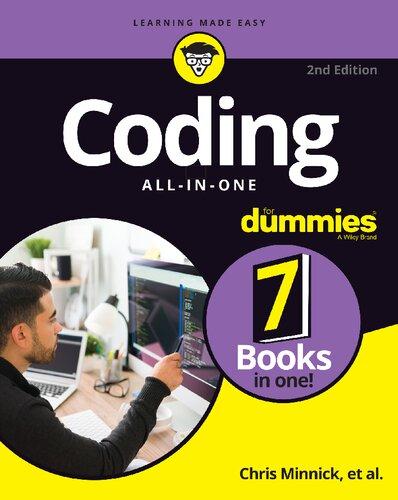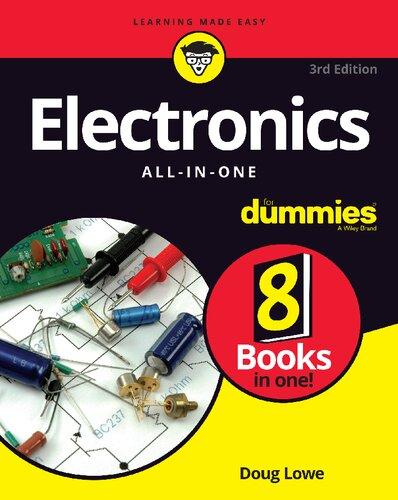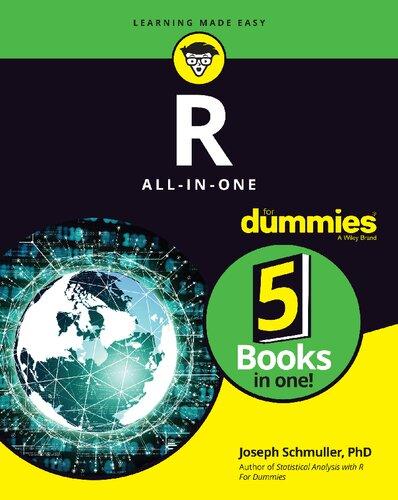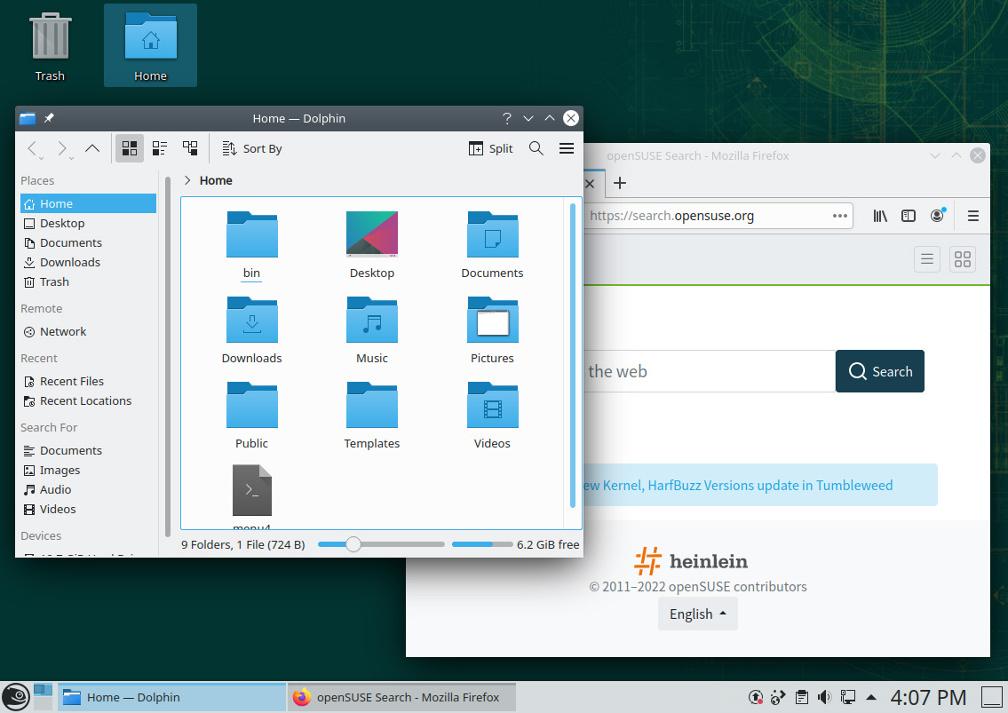Linux® ALL-IN-ONE
7th Edition
by Richard Blum
Linux® All-in-One For Dummies®, 7th Edition
Published by: John Wiley & Sons, Inc., 111 River Street, Hoboken, NJ 07030-5774, www.wiley.com
Copyright © 2023 by John Wiley & Sons, Inc., Hoboken, New Jersey
Published simultaneously in Canada
No part of this publication may be reproduced, stored in a retrieval system or transmitted in any form or by any means, electronic, mechanical, photocopying, recording, scanning or otherwise, except as permitted under Sections 107 or 108 of the 1976 United States Copyright Act, without the prior written permission of the Publisher. Requests to the Publisher for permission should be addressed to the Permissions Department, John Wiley & Sons, Inc., 111 River Street, Hoboken, NJ 07030, (201) 748-6011, fax (201) 748-6008, or online at http://www.wiley.com/go/ permissions.
Trademarks: Wiley, For Dummies, the Dummies Man logo, Dummies.com, Making Everything Easier, and related trade dress are trademarks or registered trademarks of John Wiley & Sons, Inc. and may not be used without written permission. Linux is a registered trademark of Linus Torvalds in the US and other countries. All other trademarks are the property of their respective owners. John Wiley & Sons, Inc. is not associated with any product or vendor mentioned in this book.
LIMIT OF LIABILITY/DISCLAIMER OF WARRANTY: WHILE THE PUBLISHER AND AUTHORS HAVE USED THEIR BEST EFFORTS IN PREPARING THIS WORK, THEY MAKE NO REPRESENTATIONS OR WARRANTIES WITH RESPECT TO THE ACCURACY OR COMPLETENESS OF THE CONTENTS OF THIS WORK AND SPECIFICALLY DISCLAIM ALL WARRANTIES, INCLUDING WITHOUT LIMITATION ANY IMPLIED WARRANTIES OF MERCHANTABILITY OR FITNESS FOR A PARTICULAR PURPOSE. NO WARRANTY MAY BE CREATED OR EXTENDED BY SALES REPRESENTATIVES, WRITTEN SALES MATERIALS OR PROMOTIONAL STATEMENTS FOR THIS WORK. THE FACT THAT AN ORGANIZATION, WEBSITE, OR PRODUCT IS REFERRED TO IN THIS WORK AS A CITATION AND/ OR POTENTIAL SOURCE OF FURTHER INFORMATION DOES NOT MEAN THAT THE PUBLISHER AND AUTHORS ENDORSE THE INFORMATION OR SERVICES THE ORGANIZATION, WEBSITE, OR PRODUCT MAY PROVIDE OR RECOMMENDATIONS IT MAY MAKE. THIS WORK IS SOLD WITH THE UNDERSTANDING THAT THE PUBLISHER IS NOT ENGAGED IN RENDERING PROFESSIONAL SERVICES. THE ADVICE AND STRATEGIES CONTAINED HEREIN MAY NOT BE SUITABLE FOR YOUR SITUATION. YOU SHOULD CONSULT WITH A SPECIALIST WHERE APPROPRIATE. FURTHER, READERS SHOULD BE AWARE THAT WEBSITES LISTED IN THIS WORK MAY HAVE CHANGED OR DISAPPEARED BETWEEN WHEN THIS WORK WAS WRITTEN AND WHEN IT IS READ. NEITHER THE PUBLISHER NOR AUTHORS SHALL BE LIABLE FOR ANY LOSS OF PROFIT OR ANY OTHER COMMERCIAL DAMAGES, INCLUDING BUT NOT LIMITED TO SPECIAL, INCIDENTAL, CONSEQUENTIAL, OR OTHER DAMAGES.
For general information on our other products and services, please contact our Customer Care Department within the U.S. at 877-762-2974, outside the U.S. at 317-572-3993, or fax 317-572-4002. For technical support, please visit https://hub.wiley.com/community/support/dummies.
Wiley publishes in a variety of print and electronic formats and by print-on-demand. Some material included with standard print versions of this book may not be included in e-books or in print-on-demand. If this book refers to media such as a CD or DVD that is not included in the version you purchased, you may download this material at http://booksupport.wiley.com. For more information about Wiley products, visit www.wiley.com.
Library of Congress Control Number: 2022945629
ISBN 978-1-119-90192-1 (pbk); ISBN 978-1-119-90194-5 (ebk); ISBN 978-1-119-90193-8 (ebk)
Book 2: Linux Desktops
Book 3: Networking
CHAPTER 1: Connecting to the Internet
Book 4: Administration
CHAPTER 1: Working with the Shell
Book 5: Managing Linux Servers
Book 6: Security
Book 7: Scripting
Book 8: Linux Certification
CHAPTER 2: Studying for the CompTIA Linux+ Exam
CHAPTER 3: Other Linux Certifications
BOOK 4: ADMINISTRATION
BOOK 7: SCRIPTING
Exploring bash’s built-in commands
CHAPTER 2: Advanced Shell Scripting
Trying Out sed
Working with awk and sed
Step 1: Pull out the ISBN
Step 2: Calculate the 13th digit
Step 3: Add the 13th digit to the other 12
Step 4: Finish the process
Final Notes on Shell Scripting
Introducing Linux
The Linux operating system has become one of the most widely used operating systems, popular among researchers, application developers, and hobbyists alike. These days, the Linux operating system can be found in an amazing range of computer environments, from mobile phones to satellites.
This chapter examines just what the Linux operating system is and why there are so many different Linux distributions available to choose from. With this information, you can select the right Linux distribution for your environment.
What Is Linux?
If you’ve never worked with Linux before, you may be confused as to why there are so many different versions of it available. You’ve most likely come across terms such as distribution, LiveDVD, and GNU when looking at Linux packages, and you may have been confused. This section takes some of the mystery out of the Linux system for you.
Although people usually refer to the Linux operating system as just “Linux,” in reality there are quite a few parts that make up a complete Linux system. The four main parts of a Linux system are
FIGURE 1-1: The Linux system.
» The Linux kernel
» The GNU utilities
» The user interface
» Application software
Each of these four parts has a specific job in the Linux system. Although each of the parts by itself isn’t very useful, put together, they create what people refer to as “Linux.” Figure 1-1 shows the basic diagram of how these parts fit together to create the overall Linux system.
The following sections describe these four parts in detail and give you an overview of how they work together to create a complete Linux system.
The Linux kernel
The core of the Linux system is the kernel. The kernel controls all the hardware and software on the computer system, allocating hardware when necessary and executing software when required.
If you’ve been following the Linux world at all, no doubt you’ve heard the name Linus Torvalds. Linus is the person responsible for creating the first Linux kernel software while he was a student at the University of Helsinki. He intended it to be a copy of the Unix system, at the time a popular operating system used at many universities.
After developing the Linux kernel, Linus released it to the Internet community and solicited suggestions for improving it. This simple process started a revolution in the world of computer operating systems. Soon Linus was receiving suggestions from students as well as professional programmers from around the world.
Allowing anyone to change programming code in the kernel would result in complete chaos. To simplify things, Linus acted as a central point for all improvement suggestions. It was ultimately Linus’s decision whether to incorporate suggested code in the kernel. This same concept is still in place with the Linux kernel code, except that instead of just Linus controlling the kernel code, a team of developers has taken on the task.
The kernel is primarily responsible for four main functions:
» System memory management
» Software program management
» Hardware management
» File system management
The following sections explore the first three functions in more detail. File system management in Linux can be somewhat complicated; Book 2, Chapter 5 dives into that topic.
System memory management
One of the primary functions of the operating system kernel is memory management. Memory management is the ability to control how programs and utilities run within the memory restrictions of the system. Not only does the kernel manage the physical memory available on the system, but it can also create and manage virtual memory (memory that doesn’t actually exist but is created on the hard drive and treated as real memory).
It does this by using space on the hard disk called the swap space. The kernel swaps the contents of virtual memory locations back and forth from the swap space to the actual physical memory. This allows the system to think there is more memory available than what physically exists, as shown in Figure 1-2.
The memory locations are grouped into blocks called pages. The kernel locates each page of memory either in the physical memory or the swap space. The kernel then maintains a table of the memory pages that indicates which pages are in physical memory and which pages are swapped out to disk.
FIGURE 1-2:
The kernel keeps track of which memory pages are in use and automatically copies memory pages that have not been accessed for a period of time to the swap space area (called swapping out) — even if other memory is available. When a program wants to access a memory page that has been swapped out, the kernel must make room for it in physical memory by swapping out a different memory page and swapping in the required page from the swap space. Obviously, this process takes time and can slow down a running process. The process of swapping out memory pages for running applications continues for as long as the Linux system is running.
Software program management
With the Linux operating system, a running program is called a process. A process can run in the foreground, displaying output on a display, or it can run in the background, doing work behind the scenes. The kernel controls how the Linux system manages all the processes running on the system.
The kernel creates the first process, called the init process, to start all other processes on the system. When the kernel starts, it loads the init process into virtual memory. As the kernel starts each additional process, it gives it a unique area in virtual memory to store the data and code that the process uses.
A few different types of init process implementations are available in Linux, but these days, the two most popular are
» SysVinit: The SysVinit initialization method was the original method used by Linux and was based on the Unix System V initialization method. Though it is not used by many Linux distributions these days, you still may find it around in older Linux distributions.
The Linux system memory map.
» systemd: The systemd initialization method was created in 2010 and has become the most popular initialization and process management system used by Linux distributions.
The SysVinit initialization method primarily utilizes scripts to start and stop applications as needed, while the systemd initialization method uses configuration files. Book 4, Chapter 2 explores how each of these initialization methods works and how you can configure them to customize which applications your Linux system starts automatically.
Hardware management
Still another of the kernel’s responsibilities is hardware management. Any device that the Linux system must communicate with needs driver code inserted inside the kernel code. The driver code in the kernel allows the kernel to pass data back and forth to the device, acting as a middleman between applications and the hardware. There are two methods used for inserting device driver code in the Linux kernel:
» Drivers compiled in the kernel
» Driver modules added to the kernel during runtime
Originally, the only way to insert device driver code was to recompile the kernel and restart the system. Each time you added a new device to the system, you had to recompile the kernel code and restart. This process became even more inefficient as Linux kernels supported more hardware and as removable storage devices (such as USB sticks) became more popular. Fortunately, Linux developers devised a better method to insert driver code into the running kernel.
Programmers developed the concept of kernel modules to allow the insertion of device driver code into a running kernel without having to recompile the kernel. Also, a kernel module could be removed from the kernel when the system had finished using the device. This greatly simplified and expanded using hardware with Linux.
Book 4, Chapter 2 also dives into driver modules and how to use them in your Linux system.
GNU utilities
Besides having a kernel to control memory, software, and hardware devices, a computer operating system needs utilities to perform standard functions, such
as handling files and programs. Although Linus created the Linux system kernel, he had no system utilities to run on it. Fortunately for him, at the same time he was working, a group of people were working together on the Internet trying to develop a standard set of computer system utilities that mimicked the popular Unix operating system.
The GNU Project (GNU stands for GNU’s Not Unix — a recursive acronym) developed a complete set of Unix utilities but had no kernel system to run them on. These utilities were developed under a software philosophy called open-source software (OSS).
The concept of OSS allows programmers to develop software and then release it to the world with no licensing fees attached. Anyone can use the software, modify it, or incorporate it into their own system without having to pay a license fee. Uniting Linus’s Linux kernel with the GNU operating system utilities created a complete, functional, free operating system.
Although the bundling of the Linux kernel and GNU utilities is often just called Linux, you’ll see some Linux purists on the Internet refer to it as the GNU/Linux system to give credit to the GNU Project for its contributions to the cause.
The GNU Project was mainly designed for Unix system administrators to have a Unixlike environment available. This focus resulted in the project porting many common Unix system commandline utilities. The core bundle of utilities supplied for Linux systems is called the coreutils package.
The GNU coreutils package consists of three parts:
» Utilities for handling files
» Utilities for manipulating text
» Utilities for managing processes
Each of these three main groups of utilities contains several utility programs that are invaluable to the Linux system administrator and programmer.
Linux user interfaces
Having a world-class operating system that can manage your computer hardware and software is great, but you need some way to communicate with it. With the popularity of Microsoft Windows, desktop computer users expect some type of graphical display to interact with their system. This spurred more development in the OSS community, and the Linux graphical desktops emerged.
Linux is famous for being able to do things in more than one way, and no place is this more relevant than in graphical desktops. There are a plethora of graphical desktops you can choose from in Linux. The following sections describe a few of the more popular ones.
The X Window system
There are two basic elements that control your video environment: the video card in your workstation and your monitor. To display fancy graphics on your computer, the Linux software needs to know how to talk to both of them.
The X Window software is a lowlevel program that works directly with the video card and monitor in the workstation and controls how Linux applications can present fancy windows and graphics on your computer.
Linux isn’t the only operating system that uses X Window; there are versions written for many different operating systems. In the Linux world, there are a few different software packages that can implement it, but there are two that are most commonly used:
» X.org: Based on the original Unix X Window System version 11 (often called X11), it’s the older of the two packages.
» Wayland: More Linux distributions are migrating to the Wayland software, a newer X Window package that is touted to be more secure and easier to maintain.
When you first install a Linux distribution, it attempts to detect your video card and monitor and then creates an X Window configuration file that contains the required information. During installation, you may notice a time when the installation program scans your monitor for supported video modes. Sometimes this causes your monitor to go blank for a few seconds. Because there are lots of different types of video cards and monitors out there, this process can take a little while to complete.
The core X Window software produces a graphical display environment but nothing else. Although this is fine for running individual applications, it isn’t too useful for day-to-day computer use. There is no desktop environment allowing users to manipulate files or launch programs. To do that, you need a desktop environment on top of the X Window system software.
The KDE Plasma desktop
The K Desktop Environment (KDE) was first released in 1996 as an opensource project to produce a graphical desktop similar to the Microsoft Windows
FIGURE 1-3:
The KDE Plasma desktop in openSUSE.
environment. The KDE desktop incorporates all the features you’re probably familiar with if you’re a Windows user. Figure 1-3 shows the current version, called KDE Plasma, running in the openSUSE Linux distribution.
The KDE project also maintains lots of common desktop applications that run in KDE Plasma. Book 2, Chapter 2 explores all the features of the KDE Plasma desktop environment.
The GNOME desktop
The GNU Network Object Model Environment (GNOME) is another popular Linux desktop environment. First released in 1999, GNOME has become the default desktop environment for many Linux distributions (the most popular being Red Hat Enterprise Linux).
The GNOME desktop underwent a radical change with version 3, released in 2011. It departed from the standard look and feel of most desktops that use standard menu bars and task bars, and instead made the interface more menu-driven so it would be user-friendly across multiple platforms, such as tablets and mobile phones. This change led to controversy, spawning many new desktops that kept the GNOME 2 look. Figure 1-4 shows the standard GNOME 3 desktop used in the Ubuntu Linux distribution.












